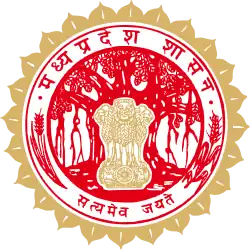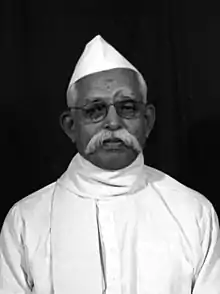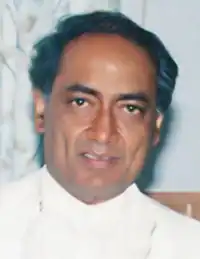List of chief ministers of Madhya Pradesh
The Chief Minister of Madhya Pradesh is the chief executive of the Indian state of Madhya Pradesh. In accordance with the Constitution of India, the governor is a state's de jure head, but de facto executive authority rests with the chief minister. Following elections to the Madhya Pradesh Legislative Assembly, the state's governor usually invites the party (or coalition) with a majority of seats to form the government. The governor appoints the chief minister, whose council of ministers are collectively responsible to the assembly. Given the confidence of the assembly, the chief minister's term is for five years and is subject to no term limits.[1]
| Chief Minister of Madhya Pradesh | |
|---|---|
 | |
| Style | The Honourable (Formal) Mr. Chief Minister (Informal) |
| Status | Head of Government |
| Abbreviation | CM |
| Member of | Madhya Pradesh Legislative Assembly |
| Reports to | Governor of Madhya Pradesh |
| Appointer | Governor of Madhya Pradesh |
| Term length | At the confidence of the assembly Chief minister's term is for five years and is subject to no term limits.[1] |
| Inaugural holder | Ravishankar Shukla |
| Formation | 1 November 1956 |
Following Madhya Pradesh's reorganisation on 1 November 1956, 18 people served as its chief minister. Twelve of these belonged to the Indian National Congress, including the inaugural officeholder Ravishankar Shukla. The first non-Congress chief minister was Govind Narayan Singh who defected from the party and lead a Samyukta Vidhayak Dal government from 1967 to 1969. Digvijaya Singh of the Congress became the first officeholder to serve two full five-year terms. He was succeeded by Uma Bharti of the Bharatiya Janata Party, Madhya Pradesh's only woman chief minister. Shivraj Singh Chouhan of the Bharatiya Janata Party is the longest-serving and current incumbent.
Precursor states
Vindhya Pradesh (1948-1956)
In 1948, the eastern regions of Central India Agency, became the Union of Baghelkhand and Bundelkhand States later renamed to Vindhya Pradesh in 1952. It was admitted into the union as a "Part B" state.
| No | Portrait | Name | Tenure | Assembly | Appointed by | Party | |||
|---|---|---|---|---|---|---|---|---|---|
| 1 | Awadhesh Pratap Singh | 28 May 1948 | 15 April 1949 | 322 days | Not yet created | Rameshwar Prasad Singh | Independent | ||
| 2 | S. N. Mehta | 15 April 1949 | 31 March 1952 | 2 years, 351 days | Martand Singh | Indian National Congress | |||
| 3 | Sambhu Nath Shukla | 31 March 1952 | 31 October 1956 | 4 years, 214 days | 1st (1952 elections) | ||||
Madhya Bharat (1948-1956)
In 1948, the western regions of Central India Agency and the Gwalior and Indore residencies, became the new state of Madhya Bharat. It was admitted into the union as a "Part B" state.
| No | Portrait | Name | Tenure | Assembly | Appointed by | Party | |||
|---|---|---|---|---|---|---|---|---|---|
| 1 |  |
Liladhar Joshi | 28 May 1948 | May 1949 | Not yet created | Jivaji Rao Scindia | Indian National Congress | ||
| 2 | Gopi Krishna Vijayvargiya | May 1949 | 18 October 1950 | ||||||
| 3 | Takhatmal Jain | 18 October 1950 | 31 March 1952 | 1 year, 165 days | |||||
| 4 | Mishrilal Gangwal | 31 March 1952 | 16 April 1955 | 3 years, 16 days | 1st (1952 elections) | ||||
| (3) | Takhatmal Jain | 16 April 1955 | 31 October 1956 | 1 year, 198 days | |||||
Bhopal State (1949-1956)
On 30 April 1949, Sir Hamidullah Khan, the Nawab of Bhopal signed an Instrument of Accession to the Dominion of India. The state of Bhopal was taken over by the Union Government on 1 June 1949 and was declared a "Part C" state.
| No | Portrait | Name | Tenure[2][3] | Assembly | Party | |||
|---|---|---|---|---|---|---|---|---|
| 1 |  |
Shankar Dayal Sharma | 31 March 1952 | 31 October 1956 | 4 years, 214 days | 1st (1952 elections) |
Indian National Congress | |
List of Chief Ministers of Madhya Pradesh
After the independence of India, the state of Madhya Pradesh was created in 1950 from the Central Provinces and Berar and the princely state of Makrai with Nagpur as the capital of the state.
The States Reorganisation Act, 1956 merged the states of Madhya Bharat, Vindhya Pradesh, and Bhopal were merged into Madhya Pradesh and the Marathi-speaking southern region Vidarbha, which included Nagpur, was ceded to Bombay. In November 2000, as part of the Madhya Pradesh Reorganization Act the southeastern portion of the state was split off to form the new state of Chhattisgarh.
| No | Portrait | Name | Constituency | Tenure[4][5] | Assembly (election) |
Party[lower-alpha 1] | |||
|---|---|---|---|---|---|---|---|---|---|
| 1 |  | Ravishankar Shukla[6] |
N/A |
26 January 1950 | 30 March 1952 | 6 years, 340 days | Not yet created | Indian National Congress | |
| Saraipali | 31 March 1952 | 31 October 1956 | 1st[7] (1952 election) | ||||||
| 1 November 1956 | 31 December 1956 | ||||||||
| 2 | 
| Bhagwantrao Mandloi | Khandwa | 9 January 1957 | 31 January 1957 | 22 days | |||
| 3 |  | Kailash Nath Katju | Jaora | 31 January 1957 | 14 March 1957 | 5 years, 40 days | |||
| 14 March 1957 | 12 March 1962 | 2nd (1957 election) | |||||||
| (2) | 
| Bhagwantrao Mandloi | Khandwa | 12 March 1962 | 30 September 1963 | 1 year, 202 days | 3rd (1962 election) | ||
| 4 | Dwarka Prasad Mishra | Katangi | 30 September 1963 | 8 March 1967 | 3 years, 303 days | ||||
| 8 March 1967 | 30 July 1967 | 4th (1967 election) | |||||||
| 5 | 
| Govind Narayan Singh | Rampur-Baghelan | 30 July 1967 | 13 March 1969 | 1 year, 226 days | Samyukta Vidhayak Dal | ||
| 6 | 
| Nareshchandra Singh | Pussore | 13 March 1969 | 26 March 1969 | 13 days | |||
| 7 | .jpg.webp) | Shyama Charan Shukla | Rajim | 26 March 1969 | 29 January 1972 | 2 years, 309 days | Indian National Congress | ||
| 8 | 
| Prakash Chandra Sethi | Ujjain Uttar | 29 January 1972 | 22 March 1972 | 3 years, 328 days | |||
| 23 March 1972 | 23 December 1975 | 5th (1972 election) | |||||||
| (7) | .jpg.webp) | Shyama Charan Shukla | Rajim | 23 December 1975 | 30 April 1977 | 1 year, 128 days | |||
| – | 
| Vacant[lower-alpha 2] (President's rule) | N/A | 30 April 1977 | 23 June 1977 | 54 days | Dissolved | N/A | |
| 9 |  | Kailash Chandra Joshi | Bagli | 24 June 1977 | 18 January 1978 | 208 days | 6th (1977 election) | Janata Party | |
| 10 | Virendra Kumar Sakhlecha | Jawad | 18 January 1978 | 20 January 1980 | 2 years, 2 days | ||||
| 11 | Sunderlal Patwa | Mandsaur | 20 January 1980 | 17 February 1980 | 28 days | ||||
| – | 
| Vacant[lower-alpha 2] (President's rule) | N/A | 17 February 1980 | 9 June 1980 | 113 days | Dissolved | N/A | |
| 12 |  | Arjun Singh | Churhat | 9 June 1980 | 10 March 1985 | 4 years, 277 days | 7th (1980 election) | Indian National Congress | |
| 11 March 1985 | 13 March 1985 | 8th (1985 election) | |||||||
| 13 |  | Motilal Vora | Durg | 13 March 1985 | 14 February 1988 | 2 years, 338 days | |||
| (12) |  | Arjun Singh | Kharsia | 14 February 1988 | 25 January 1989 | 346 days | |||
| (13) |  | Motilal Vora | Durg | 25 January 1989 | 9 December 1989 | 318 days | |||
| (7) | .jpg.webp) | Shyama Charan Shukla | 9 December 1989 | 5 March 1990 | 86 days | ||||
| (11) | Sunderlal Patwa | Bhojpur | 5 March 1990 | 15 December 1992 | 2 years, 285 days | 9th (1990 election) | Bharatiya Janata Party | ||
| – | 
| Vacant[lower-alpha 2] (President's rule) | N/A | 15 December 1992 | 6 December 1993 | 355 days | Dissolved | N/A | |
| 14 |  | Digvijaya Singh | Chachoura | 7 December 1993 | 1 December 1998 | 10 years, 1 day | 10th (1993 election) | Indian National Congress | |
| Raghogarh | 1 December 1998 | 8 December 2003 | 11th (1998 election) | ||||||
| 15 |  | Uma Bharti | Malhara | 8 December 2003 | 23 August 2004 | 259 days | 12th (2003 election) | Bharatiya Janata Party | |
| 16 | .jpg.webp) | Babulal Gaur | Govindpura | 23 August 2004 | 29 November 2005 | 1 year, 98 days | |||
| 17 | .jpg.webp)
| Shivraj Singh Chouhan | Budhni | 29 November 2005 | 12 December 2008 | 13 years, 17 days | |||
| 12 December 2008 | 13 December 2013 | 13th (2008 election) | |||||||
| 14 December 2013 | 17 December 2018 | 14th (2013 election) | |||||||
| 18 |  |
Kamal Nath | Chhindwara | 17 December 2018 | 23 March 2020 | 1 year, 97 days | 15th (2018 election) |
Indian National Congress | |
| (17) | .jpg.webp) |
Shivraj Singh Chouhan | Budhni | 23 March 2020 | Incumbent | 3 years, 218 days | Bharatiya Janata Party | ||
Timeline

}}
Footnotes
- This column only names the chief minister's party. The state government he heads may be a complex coalition of several parties and independents; these are not listed here.
- When President's rule is in force in a state, its council of ministers stands dissolved. The office of chief minister thus lies vacant. At times, the legislative assembly also stands dissolved.[8]
References
- Durga Das Basu. Introduction to the Constitution of India. 1960. 20th Edition, 2011 Reprint. pp. 241, 245. LexisNexis Butterworths Wadhwa Nagpur. ISBN 978-81-8038-559-9. Note: although the text talks about Indian state governments in general, it applies to the specific case of Madhya Pradesh as well.
- "Honorable Chief Ministers of Madhya Pradesh" (in Hindi). Madhya Pradesh Legislative Assembly. Retrieved on 14 September 2018.
- "Instances of 'President's Rule' in Madhya Pradesh" (in Hindi). Madhya Pradesh Legislative Assembly. Retrieved on 14 September 2018.
- "Honorable Chief Ministers of Madhya Pradesh" (in Hindi). Madhya Pradesh Legislative Assembly. Retrieved on 14 September 2018.
- "Instances of 'President's Rule' in Madhya Pradesh" (in Hindi). Madhya Pradesh Legislative Assembly. Retrieved on 14 September 2018.
- V Ramu Sarma (29 August 2021). "Life and legacy of Madhya Pradesh's first leaders". Retrieved 19 October 2021.
- "Statistical Report on General Election, 1951 : To the Legislative Assembly of Madhya Pradesh" (PDF). Election Commission of India. Retrieved 14 October 2014.
- Amberish K. Diwanji. "A dummy's guide to President's rule". Rediff.com. 15 March 2005. Retrieved on 3 March 2013.